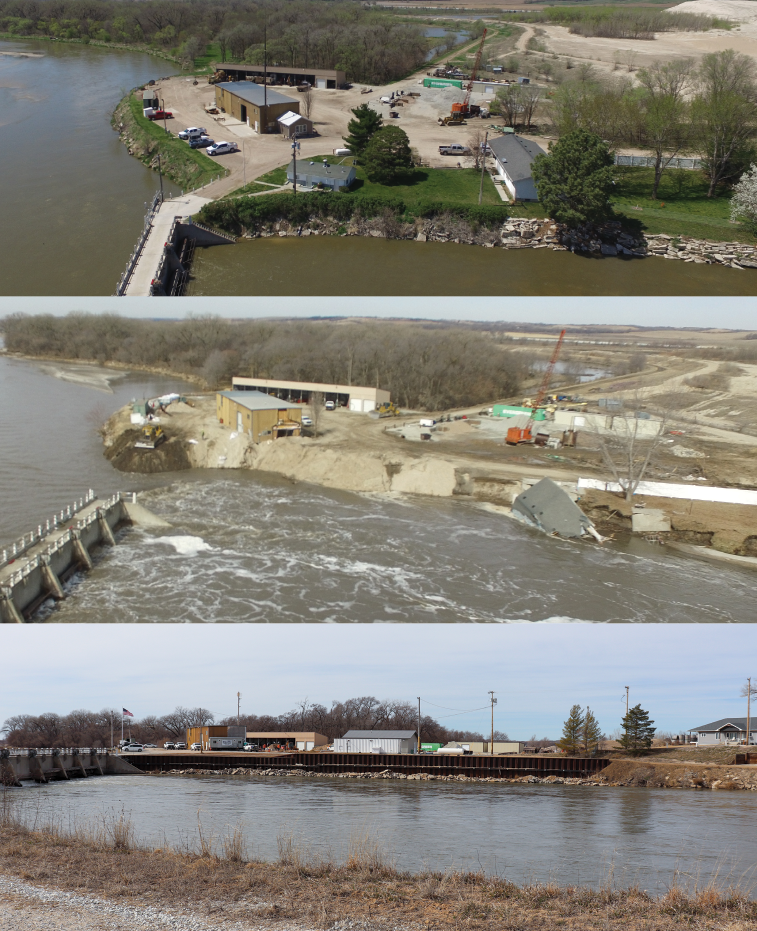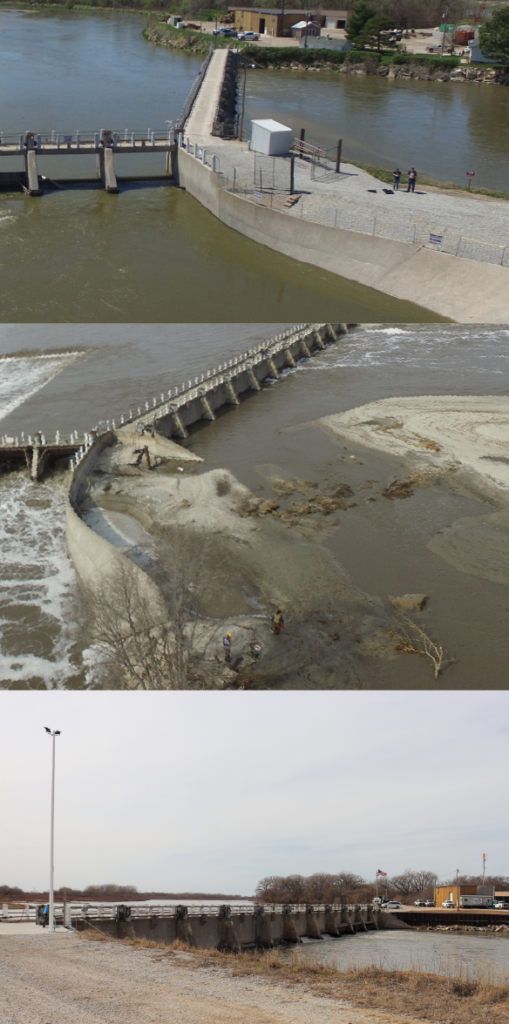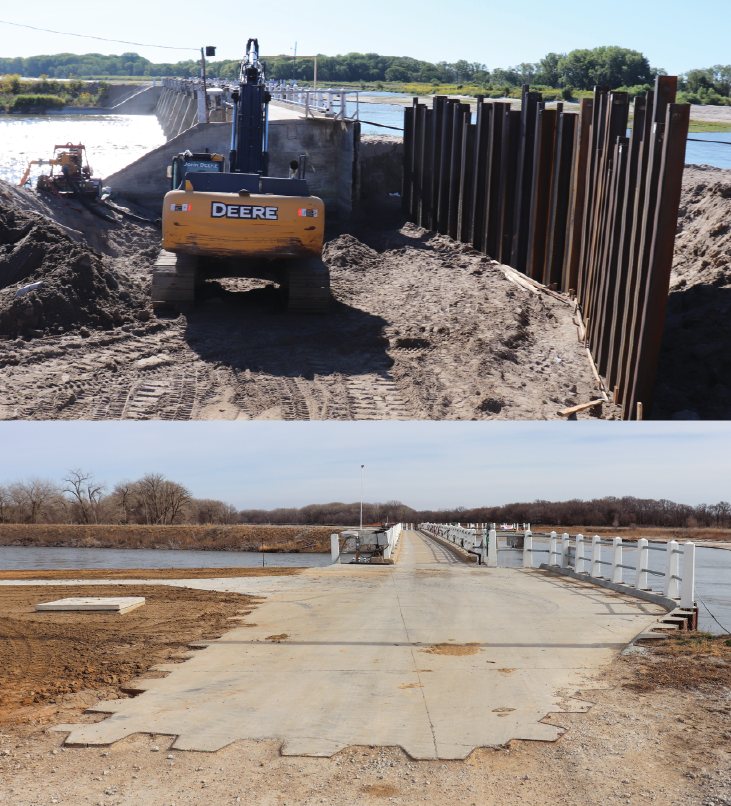Read the story originally published in the Spring 2019 issue of the Generator.
“Heartbreaking.”
“Sick to my stomach.”
“Way more than we expected.”
Memories of March 15, 2019, are painful for many Loup Power District employees.
Uncontrolled water into the canal. Six breaches. Roads washed away. A home destroyed. The shop addition ripped off and the boiler gone. The dredge full of water.
“How long it was going to take to fix wasn’t a thought in my mind,” said Hydro Superintendent Brad Morton. “It was ‘how’ and ‘where do we start?’”
Five years and 51,500 working hours later, the repair is nearing completion.
So far, the damages total more than $10 million. The Federal Emergency Management Agency has reimbursed Loup about $4.4 million.
Headworks Supervisor Randy Prososki recalls the long, difficult days right after the storm. And then, the years of work that followed.
“It’s been a long haul,” he said.

WINTER STORM ULMER
The destruction at the Genoa Headworks was caused by a series of events that caused flooding throughout Nebraska.
February was unusually cold and early March followed suit. River ice became exceptionally thick.
Headworks employees noticed it was nearly two feet thick in spots. They busted up some of that ice with dynamite and a crane on Monday, March 11.
It was so cold, that soil frost levels were deep and much of the area had several inches of snow still on the ground.
Then, the bomb cyclone Winter Storm Ulmer arrived with highs shooting into the 60s, accelerating snowmelt and dropping rain on frozen ground.
The rain and melting snow broke up river ice, causing water to surge through rivers and over land.
Federal authorities estimate damage from the flood at more than $3 billion in Nebraska alone. It’s considered one of the nation’s costliest inland flood events on record.

The area was inaccessible after the storm because the approach and the weir bridge were both destroyed.
BREACHES & DESTRUCTION
The Headworks is the start of Loup’s canal system. Employees there began noticing rising water on the evening of March 13. Late that night Headworks Supervisor Randy Prososki called extra employees in to sandbag the intake approach.
During the work, they heard a loud pop and ran toward the shop. Then they saw a light pole fall over as the whole approach disappeared.
The water began flowing north and they realized Headworks Park would likely flood. Prososki ordered them home before they weren’t able to leave at all.
Employees were anxious to survey the damage the following morning, but they couldn’t. Some roads were covered in water. Others were completely washed away.
On March 15, drone footage and a helicopter ride revealed the full damage.
“When we first got in here, my heart just sank,” Prososki said.
MAKING A PLAN
The initial reaction to the damage was so overwhelming that it seemed nearly impossible to know where to start.
“The way we went about doing the work was to stay in business,” Morton said.
That meant the first order of business was stopping the uncontrolled water coming into the canal through the two breaches at the intake.
“We quickly knew that we couldn’t do it all ourselves,” he said.
Loup was fortunate enough to have help from its neighbor, Preferred Sands, which helped create makeshift roads and carry fill material for the breaches. The biggest help came from the Nebraska National Guard, which dropped 280 massive sandbags to stop the south breach, which was inaccessible because the weir bridge washed away.
Once those big issues were tackled, it was time to look to long-term repair.
“Everybody just dug in and started to work and we came up with a plan,” said President/CEO Neal Suess.
Loup recruited help from engineering firms and other contractors. It also had to ensure that it followed procedures mandated by the Federal Energy Regulatory Commission (FERC).
Suess said Loup employees are used to dealing with emergencies like icy conditions and summer storms that may damage infrastucture. While this situation was much different, the response was the same.
“You just get down to work,” he said. “Little by little, things got done.”
And, most importantly, things got done safely, despite long hours of hard work in sometimes difficult conditions.
“The amazing thing was how people came together at the time,” Suess said.
Morton said that Loup employees’ dedication is always evident, but maybe never more so than in March of 2019.
“The great support of our company helped us endure the hardship,” he said.

Headworks Repair Timeline
2019
- New weir bridge.
- Dredge motor removed and refurbished.
- A containerized boiler was installed in a temporary location near the shop. Crews at the GHW steam the intake and sluice gates each winter to prevent ice buildup and damage. The original boiler room was washed away.
2020
- New wingwall/approach reinforced with sheet piling.
- Construction begins on new Headworks Operator home.
2021
- Headworks Park reopens following repair.
2022
- The water eroded the north bank of the settling basin. Water continued to erode fill along the bank, dumping it into the settling basin. To fix the problem, a sheet pile wall was installed. The pilings are 30′ long driven 20′ in the ground with tie backs to secure it.
- New volleyball court at Headworks Park.
- New concrete approach on the south side of the intake.
2023
- Bank repair from the Headworks to Highway 22.
- Started repairing damages to the Tailrace banks and jetties.
- Boiler moved to new, permanent spot.
2024
- Construction begins on new Headworks shop.

